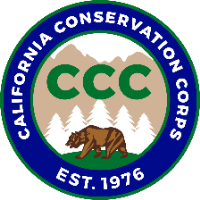Santa Maria Youth Protect Los Angeles Waterways from Post-Fire Contamination
| Sheccid Diaz, a young adult from Santa Maria, is part of a massive response to protect the burned areas of Los Angeles from taking another hit. This time from winter storms. “We’re protecting the environment—protecting the watersheds—to make sure none of the chemicals that are in burnt homes go into our oceans,” Diaz, from the California Conservation Corps (CCC) Santa Maria Center, said. “There are times where we see the residents come and check on their home and we see them break down. We just take a step back and realize this is why we’re doing this.” Diaz, a mother of two, is one of more than 400 CCC Corpsmembers, ages 18-25, mobilized by the Governor’s Office of Emergency Services (Cal OES). They’re installing miles of barriers in the Palisades and Eaton fire burn scars to filter out contaminants from rainwater runoff. “Young adults from the California Conservation Corps and from non-profit corps programs are delivering on the Governor’s commitment to fast action in keeping residents and the community safe from hazardous chemicals left in the ash and debris of the fires,” said CCC Director JP Patton. With more than 16,000 structures in need of runoff mitigation, the scale and urgency of this mission is unprecedented, requiring all hands-on deck. Through the Cal OES Watershed & Debris Flow Taskforce, the CCC joined forces with the Department of Water Resources, Caltrans, Department of Conservation, and CAL FIRE. Under the direction of engineers and environmental scientists, 32 crews are working 12-hour shifts and have placed more than 558,000 compost socks, 34,500 straw wattles, and countless gravel bags thus far. “The socks have mulch inside, so when the water pass through it filters the toxins out,” Diaz said. “If you look around, you might see a sock where on one side the water is clearer than it was entering. The dirt and grass is going to catch and help filter most of the water. But the pavement, it just goes right though, so we have to catch it. We look at where the water is going to flow and we make a little curve to the sock to catch it.” Corpsmembers received specialized Hazardous Waste Operations & Emergency Response (HAZWOPER) training in preparation for the task. It’s one of many certifications they’re earning in the CCC to protect California’s communities and environment. “When I first found the CCC, I was just looking for a job,” Diaz said. “Once I started, I just fell in love with it; the projects and conservation just made me fall in love with it.” The CCC is a State of California department offering paid training in wildland firefighting, forestry, habitat restoration, fisheries, emergency response, and more. The goal is to help California prepare for, respond to, and recover from environmental challenges exacerbated by climate change. As this watershed protection mission nears completion, CCC Corpsmembers are grateful for the opportunity to help. “Every sand bag that we put down, every sock we put down is making a difference,” Diaz says. “It just adds up through all the blocks that we’ve done. I feel proud of my crew, we push each other to do the best to help out this community.” For more information about the CalOES Watershed Protection & Debris Flow Taskforce, visit news.caloes.ca.gov. To learn more about CCC’s mission and opportunities to join, visit ccc.ca.gov. |
| Sheccid Diaz, a Corpsmember from the CCC Santa Maria Center, wears full protective equipment while giving instructions and directions to fellow Corpsmembers in front of homes destroyed in the Palisades Fire in the Pacific Palisades neighborhood of Los Angeles. CCC Santa Maria Corpsmember Sheccid Diaz, right, carries a silt sock down Sunset Boulevard in Pacific Palisades as part of the Cal OES Watershed & Debris Flow Taskforce in the Palisades Fire burn scar. A CCC Fresno Corpsmember uses a hand tool called a McLeod to compact a silt sock being installed around a drain in Altadena, to prevent potentially toxic runoff from entering the area’s watershed after the Eaton Fire. A CCC Tahoe Corpsmember picks up a metal fence post on Carbon Beach in Malibu in order to install silt fencing between properties destroyed in the Palisades Fire and the Pacific Ocean. Corpsmembers and a supervisor from the California Conservation Corps Solano Center carry a long, heavy compost sock along the beach in Malibu to prevent toxins in homes burned along Pacific Coast Highway from leeching into the ocean. |

